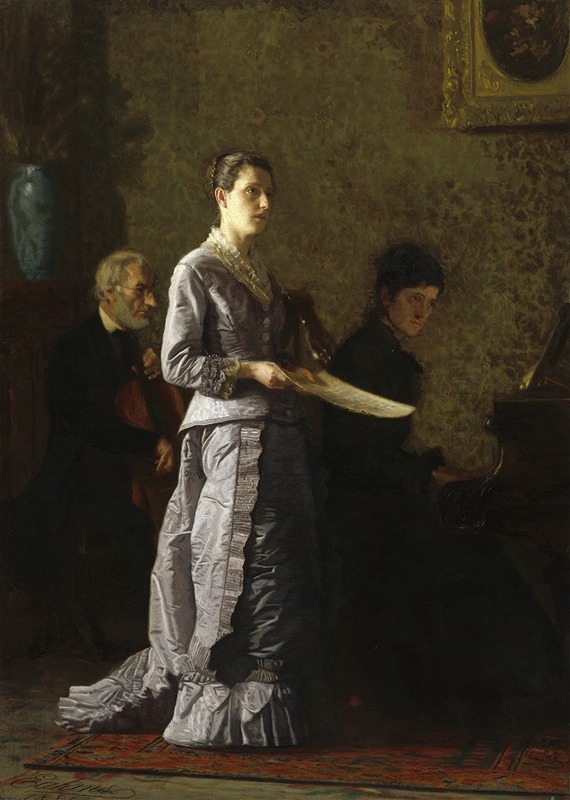
Singing a Pathetic Song
A hand-painted replica of Thomas Eakins’s masterpiece Singing a Pathetic Song, meticulously crafted by professional artists to capture the true essence of the original. Each piece is created with museum-quality canvas and rare mineral pigments, carefully painted by experienced artists with delicate brushstrokes and rich, layered colors to perfectly recreate the texture of the original artwork. Unlike machine-printed reproductions, this hand-painted version brings the painting to life, infused with the artist’s emotions and skill in every stroke. Whether for personal collection or home decoration, it instantly elevates the artistic atmosphere of any space.
"Singing a Pathetic Song" is a painting by the American artist Thomas Eakins, completed in 1881. Eakins is renowned for his realistic portrayal of the human figure and his dedication to depicting the intricacies of human emotion and experience. This particular work exemplifies his skill in capturing the subtleties of mood and expression.
The painting features a domestic interior scene, a common theme in Eakins' work, where he often explored the interplay between individuals and their environments. In "Singing a Pathetic Song," the focus is on a woman seated at a piano, deeply engrossed in her music. The title suggests that the song she is performing is melancholic, and Eakins' rendering of her expression and posture conveys a sense of introspection and emotional depth. The woman's face is partially obscured, inviting viewers to interpret her emotions through her body language and the ambiance of the setting.
Eakins' mastery of light and shadow is evident in this painting. He uses these elements to create a mood that complements the theme of the song being performed. The light falls softly on the woman and the piano, highlighting the textures of her clothing and the instrument, while the background remains subdued, drawing attention to the central figure. This technique not only enhances the emotional impact of the scene but also demonstrates Eakins' technical prowess.
The painting reflects Eakins' interest in music as a subject, which he explored in several other works. Music was a significant aspect of cultural life in the 19th century, and Eakins often depicted musicians and musical performances, capturing the intimate connection between the performer and the music. In "Singing a Pathetic Song," this connection is palpable, as the viewer is drawn into the personal experience of the woman at the piano.
Eakins' approach to painting was heavily influenced by his academic training and his commitment to realism. He studied at the Pennsylvania Academy of the Fine Arts and later in Paris, where he was exposed to the works of European masters. This background informed his meticulous attention to detail and his focus on the human form, both of which are evident in "Singing a Pathetic Song."
The painting is part of a broader body of work by Eakins that explores themes of introspection, emotion, and the human condition. His ability to convey complex emotions through subtle gestures and expressions has earned him a lasting place in the canon of American art. "Singing a Pathetic Song" is a testament to Eakins' skill as an artist and his deep understanding of the human experience.
Today, Thomas Eakins is celebrated as one of America's foremost realist painters, and his works continue to be studied and admired for their technical excellence and emotional depth. "Singing a Pathetic Song" remains an important example of his contribution to American art, illustrating his ability to capture the nuances of human emotion and the beauty of everyday life.


















![Ophelia; from Rackham’s Illustrations to Lamb’s Tales from Shakespeare [Hamlet]](/imgs/268044/s/arthur-rackham-ophelia-from-rackhams-illustrations-to-lambs-tales-from-shakespeare-hamlet-79c3d3ec.jpg)